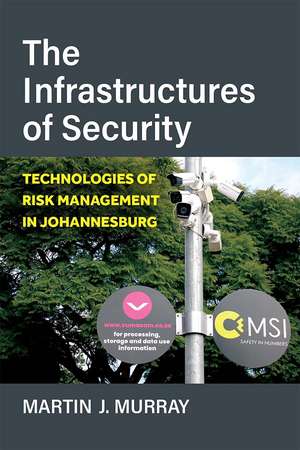The Infrastructures of Security: Technologies of Risk Management in Johannesburg: African Perspectives
Autor Martin Murrayen Limba Engleză Hardback – 15 aug 2022
In The Infrastructures of Security, author Martin J. Murray concentrates on not only the turn toward technological solutions to managing the risk of crime through digital (and software-based) surveillance and automated information systems, but also the introduction of somewhat bizarre and fly-by-night experimental “answers” to perceived risk and danger. Digitalized surveillance is significant for two reasons: first, it enables monitoring to take place across wide "geographical distances with little time delay"; and second, it allows for the active sorting, identification, and "tracking of bodies, behaviors, and characteristics of subject populations on a continuous, real-time basis." These new software-based surveillance technologies represent monitoring, tracking, and information gathering without walls, towers, or guards.
Din seria African Perspectives
-
 Preț: 192.24 lei
Preț: 192.24 lei -
 Preț: 233.69 lei
Preț: 233.69 lei -
 Preț: 273.61 lei
Preț: 273.61 lei -
 Preț: 229.93 lei
Preț: 229.93 lei - 23%
 Preț: 475.06 lei
Preț: 475.06 lei -
 Preț: 198.52 lei
Preț: 198.52 lei -
 Preț: 274.83 lei
Preț: 274.83 lei - 15%
 Preț: 469.76 lei
Preț: 469.76 lei -
 Preț: 297.90 lei
Preț: 297.90 lei - 6%
 Preț: 225.41 lei
Preț: 225.41 lei -
 Preț: 203.39 lei
Preț: 203.39 lei -
 Preț: 236.63 lei
Preț: 236.63 lei - 19%
 Preț: 480.90 lei
Preț: 480.90 lei -
 Preț: 244.90 lei
Preț: 244.90 lei - 19%
 Preț: 449.97 lei
Preț: 449.97 lei - 23%
 Preț: 530.22 lei
Preț: 530.22 lei -
 Preț: 234.32 lei
Preț: 234.32 lei -
 Preț: 171.63 lei
Preț: 171.63 lei -
 Preț: 234.22 lei
Preț: 234.22 lei -
 Preț: 203.99 lei
Preț: 203.99 lei -
 Preț: 204.58 lei
Preț: 204.58 lei -

Preț: 507.96 lei
Preț vechi: 627.11 lei
-19% Nou
Puncte Express: 762
Preț estimativ în valută:
97.23€ • 105.65$ • 81.73£
97.23€ • 105.65$ • 81.73£
Carte indisponibilă temporar
Doresc să fiu notificat când acest titlu va fi disponibil:
Se trimite...
Preluare comenzi: 021 569.72.76
Specificații
ISBN-13: 9780472075478
ISBN-10: 0472075470
Pagini: 478
Ilustrații: 18 illustrations, 3 tables
Dimensiuni: 152 x 229 x 36 mm
Greutate: 0.45 kg
Editura: UNIVERSITY OF MICHIGAN PRESS
Colecția University of Michigan Press
Seria African Perspectives
ISBN-10: 0472075470
Pagini: 478
Ilustrații: 18 illustrations, 3 tables
Dimensiuni: 152 x 229 x 36 mm
Greutate: 0.45 kg
Editura: UNIVERSITY OF MICHIGAN PRESS
Colecția University of Michigan Press
Seria African Perspectives
Notă biografică
Martin J. Murray is Professor of Urban Planning, Taubman College of Architecture and Urban Planning, University of Michigan.
Cuprins
Table of Contents
Abbreviations
List of Illustrations
Acknowledgments
Preface
Introduction
Chapter One
Policing the Post-Liberal City: Paradoxes and Contradictions
Chapter Two
Johannesburg in the Geographic Imagination: Agoraphobia and other Obsessions
Chapter Three
Vulnerable Bodies: Self-Protection in a Risky World
Chapter Four
The Surveillant Assemblage:
The Hyper-panoptic Imagination
Chapter Five
The CCTV ‘Revolution’
[With Nicky Falkof]
Chapter Six
Colliding Worlds in Micrososm
Chapter Seven
Security by Design: Spatial Management in the Hypermodern City
Epilogue Introduction
Epilogue 1
Jane Alexander Security Exhibition
Epilogue 2
Mosquito Lightning
[Carla Busuttil and Gary Charles]
Bibliography
Abbreviations
List of Illustrations
Acknowledgments
Preface
Introduction
Chapter One
Policing the Post-Liberal City: Paradoxes and Contradictions
Chapter Two
Johannesburg in the Geographic Imagination: Agoraphobia and other Obsessions
Chapter Three
Vulnerable Bodies: Self-Protection in a Risky World
Chapter Four
The Surveillant Assemblage:
The Hyper-panoptic Imagination
Chapter Five
The CCTV ‘Revolution’
[With Nicky Falkof]
Chapter Six
Colliding Worlds in Micrososm
Chapter Seven
Security by Design: Spatial Management in the Hypermodern City
Epilogue Introduction
Epilogue 1
Jane Alexander Security Exhibition
Epilogue 2
Mosquito Lightning
[Carla Busuttil and Gary Charles]
Bibliography
Recenzii
“This book provides a wealth of data on technology driven security in South Africa, as well as vivid and detailed accounts of the workings of security and its connection to societal fears. The topic is of the utmost relevance for understanding contemporary societal configurations and the role/position of the various actors in creating them.”
—Federica Duca, University of the Witwatersrand
—Federica Duca, University of the Witwatersrand
"Similar to the flying insect, security devices can be small in size and largely ignored, yet they can easily trump an individual’s rights and discriminatorily target only the unwanted ‘have-nots’. This is why critical analyses of security systems are crucial and compelling, making Murray’s book an important contribution to scholarship."
—Theoretical Criminology
—Theoretical Criminology
Descriere
The shift from dependence upon human decision-making in security services to Artificial Intelligence
